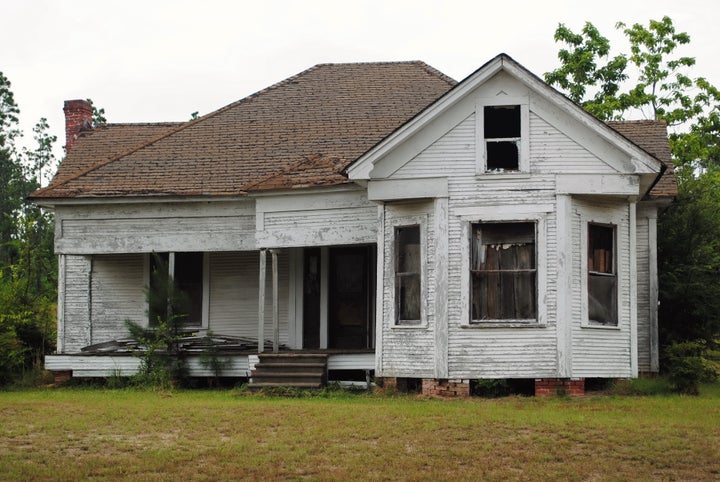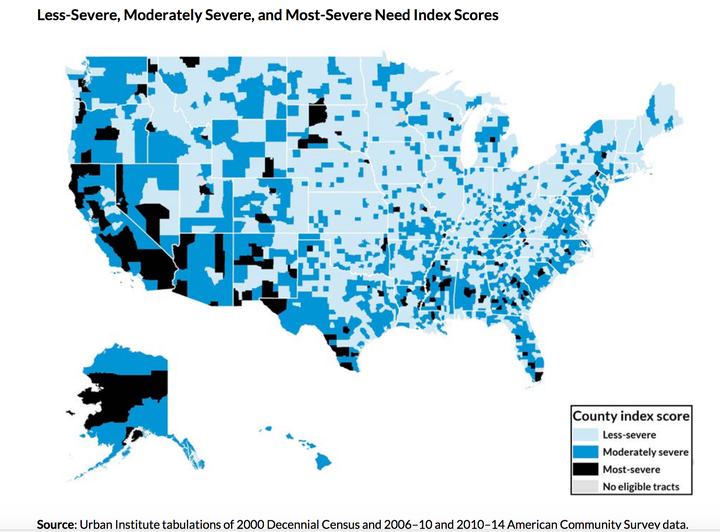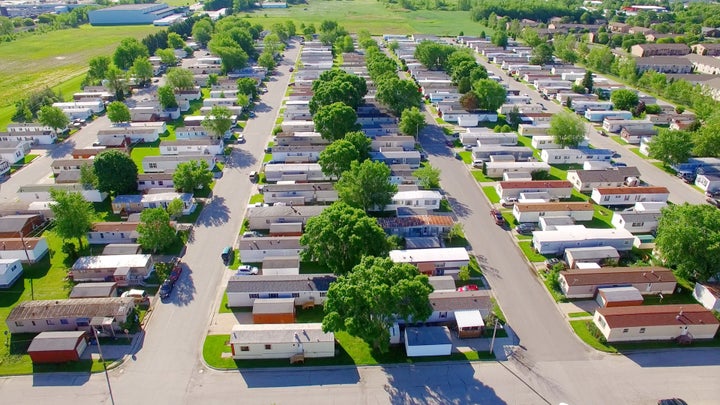
America’s well-documented affordable housing crisis is often framed in terms of the big urban areas, where housing and living costs are sky high and rapid gentrification pushes rents and prices up and lower-income residents out. But the affordability crisis is also playing out across rural America. It’s more spread out and driven by different factors, but it’s no less devastating.
A new report, published Tuesday, highlights the problem by ranking the affordable housing needs of rural communities across the country. Produced by the Urban Institute, a Washington, D.C., think thank, the report identifies 152 rural counties ― home to 8 million people ― with the most-severe needs for affordable rental housing.
While these counties are scattered across the U.S., the report identified some specific pockets of concentration, including along the border, from Texas to California; in the Southern Mississippi Delta, especially parts of Louisiana and Mississippi; and in the Southeast, including Florida, Alabama and Georgia.
Rural counties ― defined by the Urban Institute as those that qualify for U.S Department of Agriculture housing programs ― were ranked by seven factors, including high rates of population growth, high rates of poverty, low vacancy rates and high unemployment rates. Those scoring on four or more factors were identified as having the most-severe needs.
Corianne Scally, the report’s author and a senior research associate at the Urban Institute, said she was unprepared for how extreme some of the problems were. “It was surprising to see so many rural communities that are struggling with just having very few vacant rental units available, and to see so many rural communities with very few federally subsidized rental units,” she told HuffPost.

There are common threads among those communities identified as having the most severe need, according to the report. These include populations that are faster growing and poorer than average, low vacancy rates among rental homes (meaning few available homes), more overcrowding, more people paying over 50 percent of their income towards housing and fewer federally subsidized rental units.
These counties tend to also have younger and more diverse populations and a greater reliance on government employment as opposed to farming, manufacturing and mining.
Housing issues in rural communities can get overlooked as living and housing costs tend to be lower there than in the cities. However, incomes in many of these areas tends to be lower too, especially in areas that used to rely on the coal industry or that otherwise have limited job opportunities.
America’s economic boom and low unemployment rates haven’t translated into a house-building boom. Rates of construction are at almost record lows. And there are specific obstacles to building in rural areas.
Developers find it difficult to get financing there, said David Dangler, director of rural initiatives at the nonprofit NeighborWorks America. The already limited number of firms specializing in affordable rental housing is even smaller when it comes to rural markets, he told HuffPost. Rural rental housing developments tend to be significantly smaller than their urban counterparts, he said, and financing is complex.
Plus, what developers take for granted in urban areas, such as water system infrastructure, may not be available in some rural communities.
The Urban Institute is calling on policymakers to put more money into building affordable rental housing in rural America and to make it easier for that money to get to the places that need it. “We found almost 700 counties with rural communities that had equal to or less than 5 percent of federally subsidized units, so again there just hasn’t been much investment in these communities even through standard federal programs,” said Scally.
The low-income housing tax credit is a key federal tool to encourage affordable rental housing, but Scally warns about the danger of being too reliant on one program that is subject to the whims of the economy.
The report also suggests that incentives be given to developers operating in underserved rural areas. “There is definitely a need to try to get construction moving in some of these communities,” said Scally, through, for example technical assistance or financial benefits to build in areas facing shortages of construction material and labor.
It’s important to find solutions that reflect local needs, said Scally. For instance, she suggested that manufactured housing ― prefabricated homes that are made in a factory and then set up on-site ― could be one way to fill the gap in some areas. “They are usually not structured as rentals per se,” she said, “but they are usually quite affordable.”

One project run by the Community Development Corporation of Brownsville, a NeighborWorks network organization in Texas, has produced manufactured housing designed for a quick response to demands like natural disaster recovery. “The modular single family units can be readily adapted for both rental and ownership variations,” said Dangler.
Yet overall, Scally said, the production of manufactured housing has declined in the U.S.
While nonprofit and community initiatives provide a vital service, it’s policymakers that need to engage, the Urban Institute argues. State agencies must “make sure they are taking a careful look at rural needs and ... make sure that rural residents aren’t getting left behind,” said Scally. And federal funding needs to increase, she added.
A new bill, unveiled by Sen. Elizabeth Warren (D-Mass.) last month, could offer a glimmer of hope, at least if the Democrats succeed in the midterm elections. The bill aims to tackle America’s housing crisis by investing half a trillion dollars into affordable housing. It would allocate federal money to subsidize housing in rural neighborhoods and improve the quality of that housing.
The bill has the backing of the National Rural Housing Coalition, which wrote a letter of support to Warren, and the National Low Income Housing Coalition.
“Rural communities face unique challenges to addressing their housing needs, and as a result, far too many of the lowest-income seniors, people with disabilities, families with children, and other individuals in rural America cannot afford to keep a roof over their head,” said Sarah Mickelson, the National Low Income Housing Coalition’s senior director for public policy. “Senator Warren’s landmark proposal would directly help rural families struggling to pay rent and make ends meet.”
For more content and to be part of the “This New World” community, follow our Facebook page.
HuffPost’s “This New World” series is funded by Partners for a New Economy and the Kendeda Fund. All content is editorially independent, with no influence or input from the foundations. If you have an idea or tip for the editorial series, send an email to thisnewworld@huffpost.com
